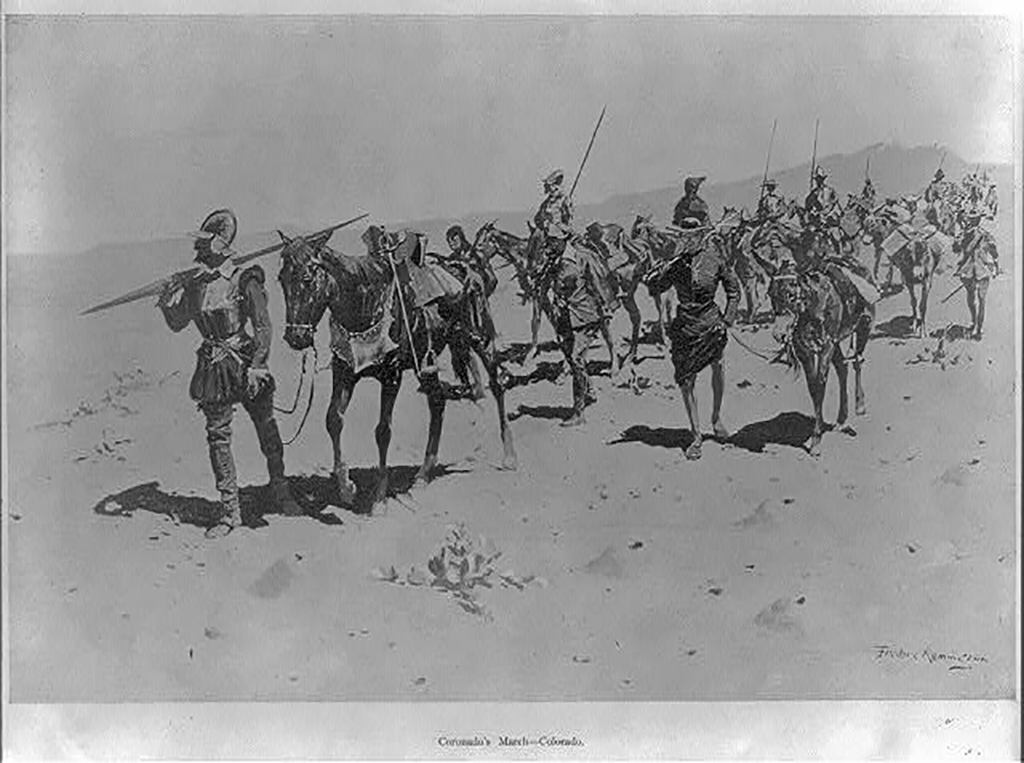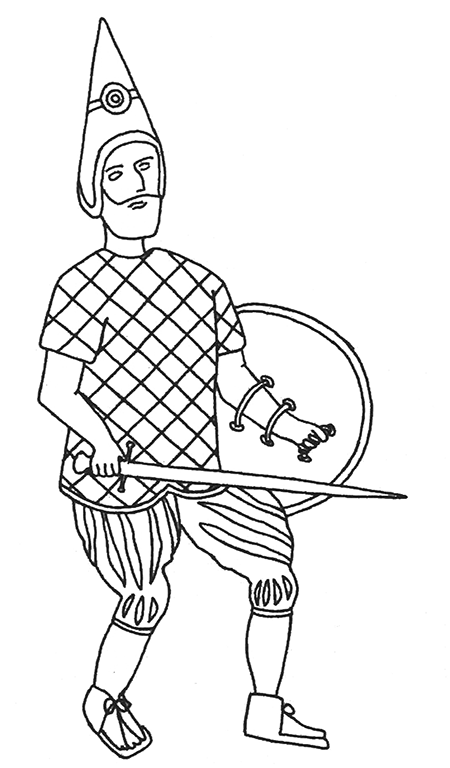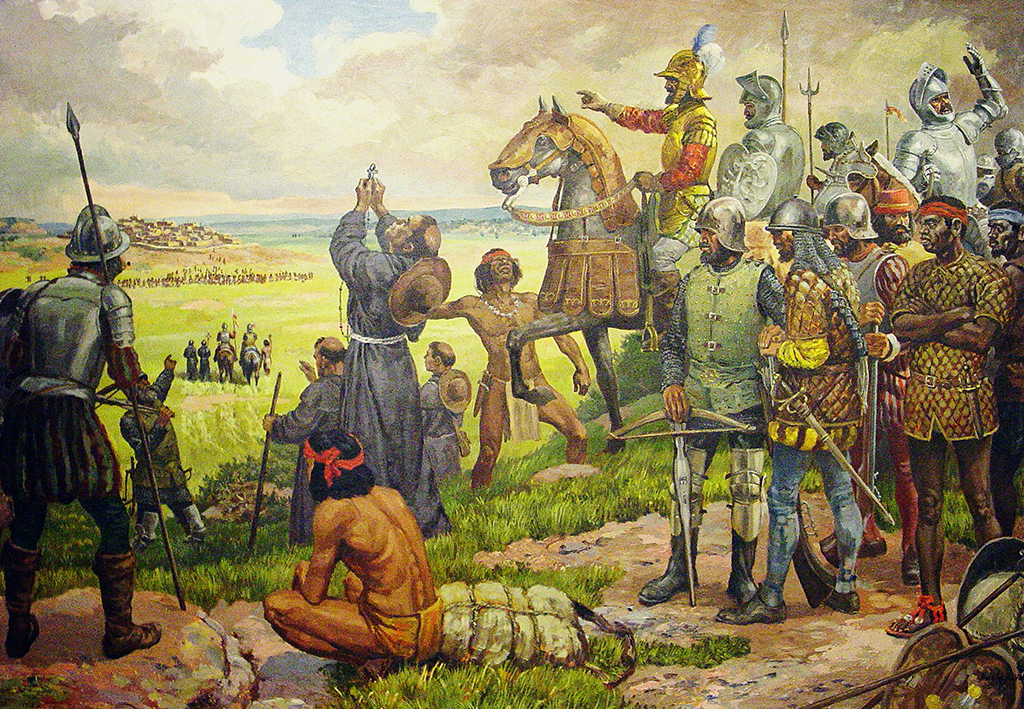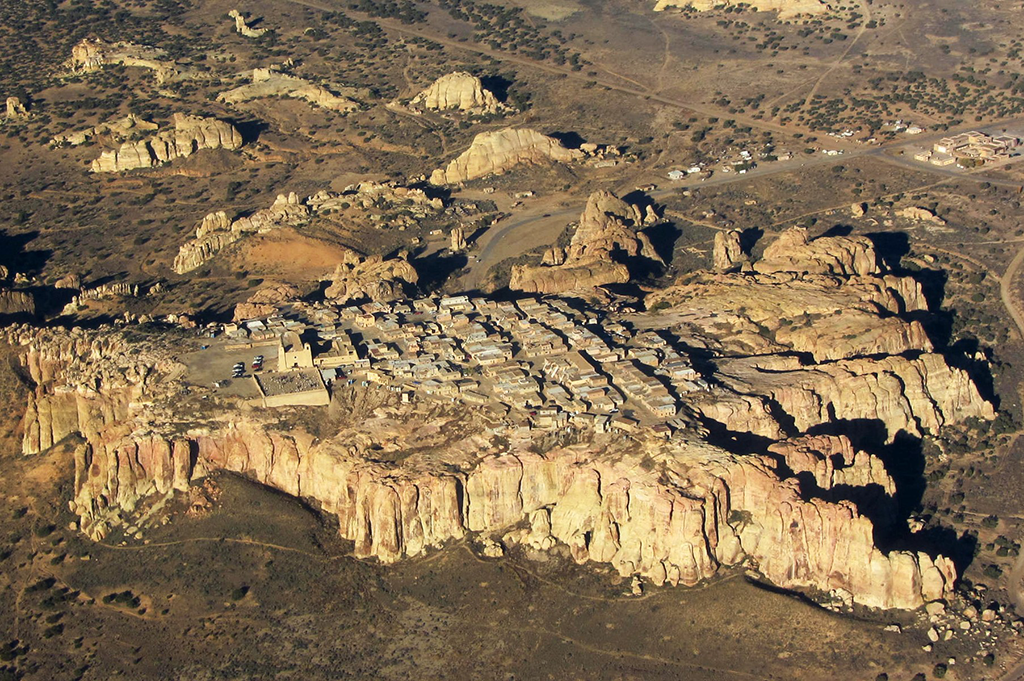However the friar, who was subsequently named provincial (administrative head) of the Franciscan Order in Mexico City, justified his misrepresentation of the truth, the story of another Mexico in the far north gained credence in late 1539. Based on Niza’s report (which essentially did nothing more than verify the existence of cities in the far north), Viceroy Mendoza remained unconvinced of Cíbola’s value. Almost immediately after Niza’s report was filed and sent to Madrid, Mendoza sent Melchior Díaz from Culiacán to retrace the friar’s steps.
Despite the viceroy’s lack of faith in the significance of Niza’s account, public opinion in the capital city was abuzz with the idea that a “new Mexico” lay hundreds of miles to the north. Fearful that ambitious settlers might attempt to organize unsanctioned expeditions to investigate, Mendoza authorized Governor Francisco Vásquez de Coronado to lead the official entrada to the Seven Cities of Cíbola. In October 1539, Mendoza wrote to the Spanish royal treasurer that he had “decided at present . . . to send as many as two hundred horsemen by land and two navíos by sea with as many as a hundred arquebusiers and crossbowmen” on the excursion.14
Although Mendoza dragged his feet based on his feeling that New Spain’s resources and manpower could be better spent than on a quixotic voyage to Cíbola, Coronado’s preparations were well underway by November. The young governor had arrived in New Spain with Mendoza’s company and had the confidence of the viceroy. As a traditional adelantado, Coronado put up his personal resources to finance and outfit the expedition. His reward would be the glory and spoils achieved in Cíbola. In all, Coronado mustered nearly 300 horsemen, 6 Franciscans (including Niza who was to be the entrada’s guide), and about 1,300 indios amigos from the areas surrounding Mexico City. Additionally, the wives and children of a few of the soldiers also accompanied the entourage. Hundreds of cattle, sheep, mules, and extra horses were tended by native allies.
Indios amigos vastly outnumbered the other members of the entrada, yet their presence was either downplayed or completely ignored in the reports filed by Coronado and his captains. Such was the traditional practice of Spanish expeditions. Indigenous allies were invaluable to the conquest, but they long remained invisible to historians because Spaniards did not so much as record the number of natives that accompanied any given expedition. The work of historians Oakah L. Jones, Jr., Richard Flint, and Shirley Cushing Flint, has recovered evidence of the indigenous allies’ contributions to the entrada. Although still unable to reconstruct the personal stories of most of these people, some existing documents recount the presence of Mexica expeditionaries, as well as others from Tlatelolco and Coyoacán. Still others were added to the entrada as it made its way through the present day states of Michoacán, Jalisco, Nayarit, and Sinaloa.
Guadalcanal native Juan Jiménez had a harsh winter to survive while on Coronado’s Expedition in 1541-42. The types of clothing Juan Jiménez would have worn include head armor, a quilted cotton tunic, and alpargates (hemp sandals). In this image, he carries a sword and rodela (a round shield). Though not mentioned in his inventory, the rodela would be standard protection for a swordsman. A winter coat probably would have been nice! Learn more about Juan Jiménez.
Dressing for the March but not the Winter
Indigenous men had many reasons for joining Coronado. Spanish colonial practice allowed local native leaders to maintain their positions of political prominence as long as they pledged loyalty to Church and Crown. Whenever colonial authorities requested men to accompany an expedition, indigenous leaders were expected to provide them. Depending on the internal dynamics of the community, volunteers might be called for, potential political challengers appointed, or a draft made. Among those that volunteered to accompany Coronado, many apparently hoped that the expedition would afford them the opportunity to escape to a place far beyond the control of Spain. After the failed entrada abandoned the Pueblos along the Rio Grande, hundreds of indios amigos took advantage of the chance to stay behind.
Viceroy Mendoza’s impressions were confirmed in the spring of 1540 when Díaz’s report made its way to his desk. Díaz’s findings were the exact opposite of those made by Niza in virtually every way possible. His party also never reached Hawikuh, but along the trail the reports that they received made it clear that the Zuni Pueblos were not large cities of spectacular wealth. Instead, they were reportedly comprised of “crudely worked buildings made of stone and mud.” Based on the intelligence he received, Díaz concluded that the far north was not suited for any purpose other than missionary work.
Ultimately, the report was of no avail. By the time Mendoza read it, Coronado’s men were already well underway. As they followed existing foot trails used by indigenous groups along the Pacific coastal plains, members of the expedition complained of intense heat and suffocating dust. The few soldiers who possessed traditional chainmail armor soon shed it in favor of the buckskin and cotton clothing worn by their indigenous allies. Since the men were required to provide most of their own equipment, and Spanish manufactures were in short supply in New Spain, very few owned crossbows, harquebuses, or swords. Instead, they armed themselves with the same types of weapons used by the natives, including atlatls, bows and arrows, slings, spears, obsidian swords, and clubs.
Coronado himself was cut from the traditional conquistador mold. In 1510, he had been born to a noble family in the province of Salamanca in Iberia. At the age of twenty-five he sought to enhance his and his family’s prestige by accompanying the newly appointed viceroy of New Spain to the Americas. Once in the colony, he set himself apart by quelling a slave rebellion. He subsequently married the daughter of the colonial treasurer and gained possession of a large estate. He proved an able administrator during his short tenure as governor of Nueva Galicia. Like many who both came before and after him, he seemed poised to make a great name for himself as conquistador.
Aware of the narrow trails and the environmental conditions that lay ahead, Coronado broke his expedition into several smaller groups that set out from Culiacán at different times. Staggering the impact of the humans and animals allowed the trail, grazing fodder, and watering holes to recover. At the halfway point to Cíbola, at a site called Los Corazones along the Rio Sonora, Coronado ordered the establishment of a villa to be called San Gerónimo. The villa was subsequently moved northward to a point in the Sonora Valley called Suya by its native inhabitants. Coronado similarly established several supply checkpoints along the route, but San Gerónimo was the only town that he commissioned.
On July 7, 1540, Coronado and his advance party arrived at Hawikuh. The Captain-General was immediately disappointed by what he encountered. The pueblo was nothing like the inflated Cities of Cíbola that Niza’s earlier foray had invented in the Spaniards’ imaginations. Coronado’s group made their way toward the town just as its inhabitants were performing a vital seasonal ceremony. To the Zuni people, the Spaniards’ interruption of their sacred rites was a major affront. Medicine men laid out a sacred corn meal line and warned the soldiers that they must not cross; to do so would be a severe act of aggression.
A small group of Spaniards neared the corn meal barrier, illustrating what the Zunis correctly perceived as a lack of respect for Pueblo religion and culture. As the man nearest the dividing line read the requerimiento in fulfillment of one of the Spaniards’ own rituals of exploration and conquest, Zuni warriors fired warning shots near the men and their animals. Coronado’s forces refused to back down, and they sacked the village in the ensuing battle. When they entered the village, the gravely disappointed soldiers fully realized the exaggerated nature of the rumors of Cíbola. A dejected Coronado called Hawikuh a poor town that had been “all crumpled together.”15 Its inhabitants did not possess gold or other forms of wealth.
Coronado was furious with Fray Marcos de Niza for perpetuating a great deception. In a letter to Viceroy Mendoza, the Captain General reported that “everything the friar had said was found [to be] the opposite.”16 Hawikuh was one of six Zuni Pueblos, not the foremost among seven cities of gold. Desperate to salvage the mission, Coronado resolved to press on in search of other settlements and, hopefully, wealth. Coronado divided his forces, sending a small group west through Hopi country and toward the Grand Canyon. The main body of the entrada headed eastward toward the Pueblos of Tiguex near present day Bernalillo. As was the purview of conquerors, before leaving Hawikuh, he renamed the village Granada because it reminded his men of the Muslim section of the Iberian city of the same name.
With cold weather fast approaching, Coronado elected to make his headquarters at Tiguex during the winter of 1540-1541. Proximity to the Rio Grande and the produce of the Tiwa peoples that inhabited the region were attractive to the weary Spaniards. As the soldiers pressured the Tiwas to provide them with food, clothing, and shelter, interactions between them became increasingly violent. Further exacerbating the situation, several Spaniards raped Tiwa women. The Pueblo people initially resolved to bear the Spaniards’ presence in order to avoid confrontation, but the Europeans’ arrogance made such an arrangement impossible.
Some of Coronado’s captains later testified that his actions placed Tiwa leaders in an untenable position. According to Pedro de Castañeda, Coronado’s demand that one headman provide the Spaniards with three-hundred items of clothing disrespected Pueblo custom. The headman informed Coronado that he lacked the authority to comply; he would first need to council with other leaders. The Captain General and others, however, refused to work with the Pueblos. Castañeda recalled that Coronado continued his demands, placing the natives in a situation with no other option than to “take off their own cloaks and hand them over until the number that the Spaniards asked for was reached.” If Spanish soldiers later encountered a Tiwa with better cloaks than their own, “they exchanged it with him without any consideration or respect, and without inquiring about the importance of the person they despoiled.” Castañeda concluded that “the Indians resented this very much.”17
Over the two winters between late 1540 and early 1542, the Spaniards’ continued demands for provisions intensified such resentment. When the people of Arenal refused to hand over provisions, Coronado’s men destroyed the Pueblo and executed thirty of its men by burning them at the stake. During what have been dubbed the Tiguex War, Spanish soldiers decimated thirteen of the fifteen Pueblos in the region along the Rio Grande. Tiwa peoples did not forget the brutality of Coronado and his men as they regrouped and rebuilt their homes in the years following his departure.
Coronado Expedition, 1540-1542
Coronado Expedition, 1540-1542
The route was followed by the Coronado expedition between 1540 and 1542. Upon their failure to locate either the Seven Cities of Cíbola or the rumored wealth of Quivira on the Great Plains, the expedition returned to Mexico City with little to show for their efforts.
Besides creating tensions and bringing outright devastation to Pueblos along the Rio Grande, Coronado’s expedition fanned out to explore other areas. One party traveled northward to Taos Pueblo, while another, led by the Captain General himself, headed to Cicuye, called Pecos Pueblo by the Spaniards. A party from Pecos had initially met the Spaniards at Hawikuh following the battle there. Coronado’s men referred to the headman of the Pecos people as Bigotes, because he apparently had a mustache. Along with the party from Pecos was a captive from among the Plains peoples whom the Spaniards referred to as El Turco (the Turk) because his appearance was similar to that of Turkish people. El Turco told Coronado and his captains of a civilization called Quivira that lay far to the west. According to his account, Quivira was a place of incredible wealth, containing vast amounts of gold and silver as well as a large population. When Bigotes claimed that Quivira was a product of the Plains captive’s imagination, El Turco accused Bigotes of withholding a silver bracelet that would prove his claims. As a result, Coronado placed Bigotes under arrest, and commissioned El Turco to lead his force towards the plains in search of Quivira.
The party set out from Pecos Pueblo, which lay on the eastern edge of the Pueblo world. By the time the Europeans reached Cicuye, its people had no doubt already heard stories of their brutality and their affinity for gold and other types of mineral wealth. When they learned the gruesome details of the attack on Hawikuh, their leaders made the decision to attempt to establish peaceful relations with the newcomers. Bigotes led his small party to Hawikuh with such purpose in mind. They brought buffalo robes, shields, headdresses, and little bells as gifts to the Spaniards to indicate their diplomatic intentions. Chronicler of the entrada, Pedro de Castañeda, wrote a description of Cicuye. He and his companions were impressed by the town “of as many as five hundred warriors.” He wrote of its many kivas and four-story construction. Castañeda also commented on Cicuye’s role as a center of trade between Pueblo and Plains peoples, and added that its people “pride themselves that no one has been able to subdue them, while they subdue what pueblos they will.”18
Shortly after their arrival, the Spaniards also read the requerimiento to those present at Cicuye. Whether or not they understood its message, the Pecos people certainly recognized its implications due to their knowledge of the events at Hawikuh. As one historian of early Latin America has illustrated, the language barrier mattered less due to the Spaniards’ use of violence and other actions taken to force the submission of indigenous peoples. The Pueblos did not understand the implications of becoming subjects of Crown and Church, but, for the most part, they wanted to avoid inciting the Europeans’ wrath. Additionally, according to Coronado’s reports, the people of Cicuye and the Tiwa pueblos were enemies. The Spaniards were able to exploit such existing divisions to facilitate their conquest of Pueblo peoples.
Despite language barriers, El Turco understood what the Spaniards were looking for. Through a difficult translation effort that involved Nahuatl-speaking indios amigos, Franciscan Fray Juan de Padilla, and elaborate gesturing, the Spaniards came to believe that at Quivira they would finally locate the Seven Cities of Cíbola. In early May 1541, having laid waste to the Tiwa Pueblos, Coronado’s entire army relocated to Cicuye. Despite Bigotes’ insistence that no such place as Quivira existed, Coronado committed all of his forces and energy to the plains. By Spanish accounts, El Turco had exaggerated his description of Quivira to the extent “that had it been true, it would have been the richest thing in the Indies.”
The motives of El Turco remain somewhat mysterious. Ultimately, his tale of Quivira resulted in Bigotes’ release from captivity when the Spaniards set out on their journey, but it also resulted in his own death at the hands of the newcomers when they learned that Quivira was, in fact, nothing more than the grass-hut villages of the Wichita people in July 1541. Once again there were no cities of Cíbola, no quick wealth, no “Nuevo México.” Although unclear what reasons he had to lead the Spaniards on a wild goose chase, El Turco’s actions mirror those of numerous other indigenous peoples that reported great civilizations of wealth in order to send the expeditionaries on their way.

By the fall of 1541, a dejected Coronado realized that his entrada had been a failure. Following one more winter at the now-abandoned Tiguex, the Captain General led his forces back toward New Spain in the spring of 1542. When the group passed through the Suya valley of Sonora, they found that the villa of San Gerónimo had been destroyed by local peoples. Few survivors remained, and the losses were personal for Coronado and many of his captains that had left family members behind. Diego de Alcaraz, one of the captains left to administer San Gerónimo, “committed many outrages” against the area’s native inhabitants. According to one survivor’s account, Alcaraz’s atrocities included “taking provisions against their will and seizing their wives and daughters in order to have sexual relations with them.”19
Coronado emerged from the expedition a broken man. His personal fortune was depleted and he stood trial for atrocities committed against the Zuni, Tiwa, and Suya peoples. Viceroy Mendoza’s attempts to ensure that the entrada avoid brutality toward indigenous peoples came to naught. Much to his chagrin, the expeditionaries’ actions seemed to provide evidence for the validity of the Black Legend. The stresses placed on them by a dry, inhospitable climate and Pueblo peoples who were unwilling to submit to their authority proved overwhelming.
The Coronado entrada underscores the inherent contradictions of Spanish colonization. The “formal policy or intent” was never deliberately to destroy native peoples’ livelihoods.20 Yet the Spaniards’ sense of political, cultural, and religious superiority targeted indigenous cultures. Colonization of indigenous peoples’ customs and beliefs proved impossible without violence—something that Spanish officials and conquistadores understood, at least implicitly. They never considered a mission of exploration or colonization without weapons.
Despite the overall failure of the Coronado entrada to conquer or settle the far north, Spaniards learned vital new information about the Pueblo world and the Great Plains. Coronado’s group was the first to see Acoma Pueblo, which Castañeda described as “one of the strongest fortresses ever seen” due to its position high atop a mesa. Members of the expedition also described the trade between Pueblo and other peoples that took place at Cicuye and Taos. Coronado’s failed attempt to locate Quivira resulted in the first European report of the Great Plains. He and others of his men described the great herds of bison that roamed free. By one account, they numbered “as many as the fish of the sea.” They also described the ways that Plains peoples hunted the buffalo before they were introduced to the horse.
Yet Coronado concluded that New Mexico was unfit for Spanish settlement. He reported that it was “impossible for anyone to spend the winter here, since there is no firewood” and few other provisions.21 Three Franciscans and hundreds of indios amigos, however, elected to stay among the Pueblos. It appears that many of the Nahuatl-speaking allies planned all along to abandon the expedition when the opportunity presented itself. Unlike Coronado, the Franciscans saw New Mexico as a place of great potential as a mission field. One of the three friars attempted to work among the Wichita people, but was killed upon his return. Although the fate of the other two is unknown, it is likely that they also met death at the hands of Pueblo people.



